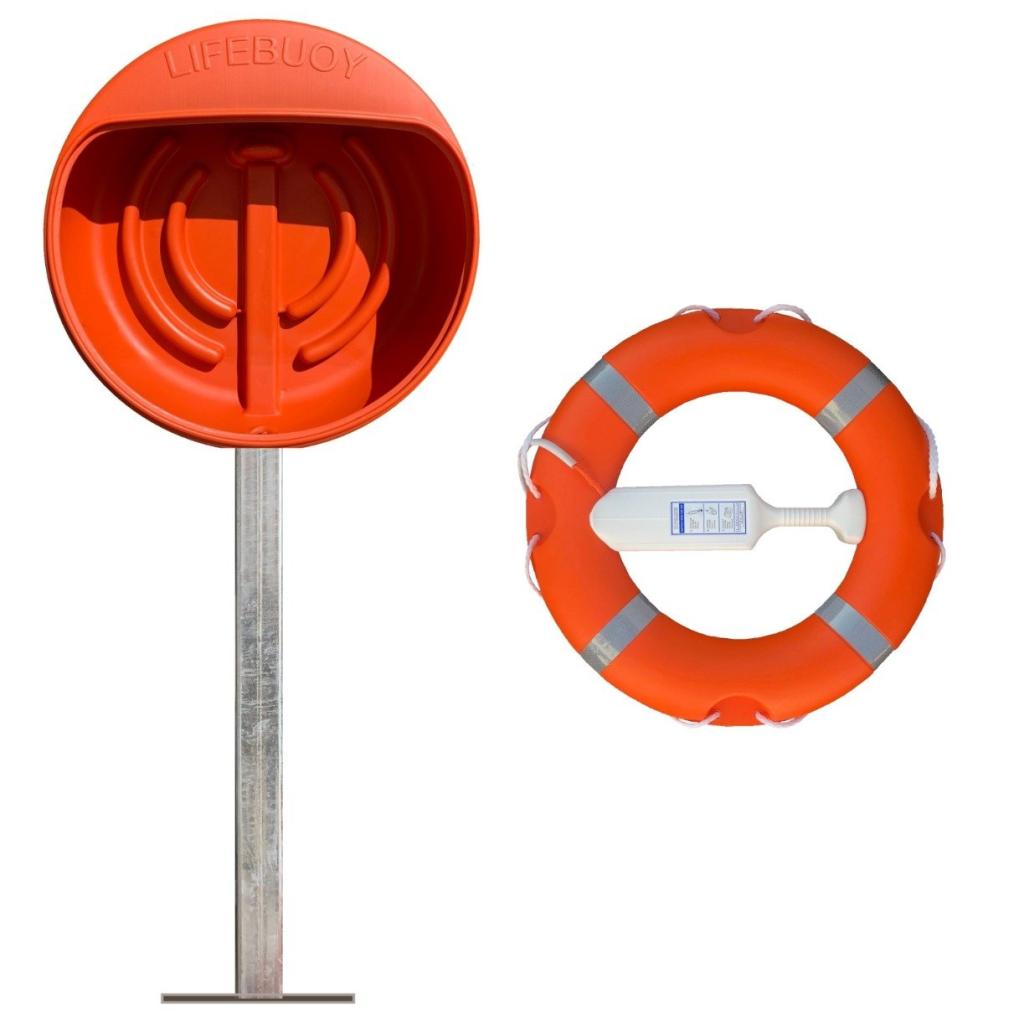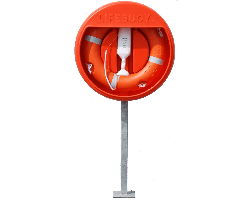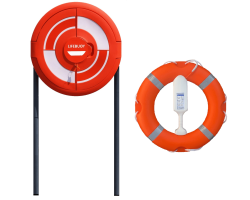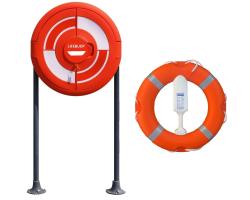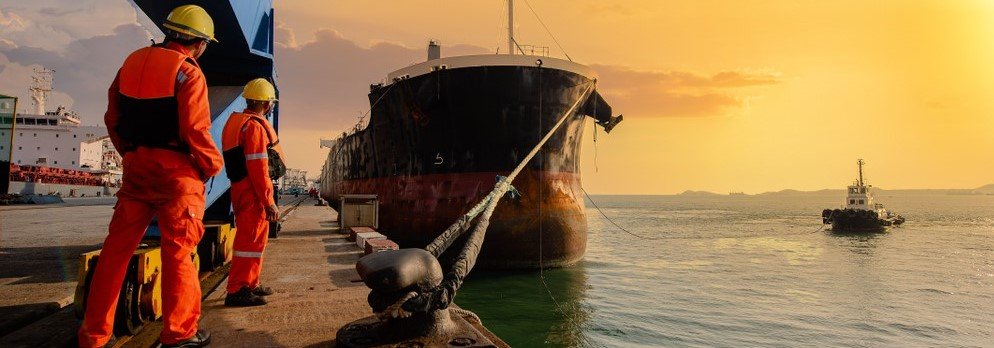Hard Surface Lifebuoy Set With Pole For Hard Ground - Budget Range Life ring Housing / Cabinet , Throwing Line and Galvanised Pole For Securing Directly To A Hard Surface
Lifebuoy, Line, Housing and Galvanised Hard-Surface Base Plate pole for securing directly to a hard surface.
Please note: The budget range cabinet front covers are a push fit design and best suited for low-footfall areas. For higher-traffic/public locations we recommend using our premium lifebuoy sets if a cabinet front cover is required.
LIFEBUOY, ENCAPSULATED LINE, BUDGET HOUSING& HARD - SURFACE POLE
This Budget Set Gives You:
- 1 x 24" or 30" Orange lifebuoy that comes complete with retro reflective tape and grab lines
- 1 x Encapsulated throwing line ( 20m for the 24" lifebuoys & 30m for the 30m lifebuoys )
- 1 x Universal budget lifebuoy housing / cabinet
- 1 x Galvanised Hard-Surface Pole for fixing directly to a hard surface through the 4 bolt holes in the base plate
- 1 x Cover for Housing ( If selected in the drop down menu )
Key Features & Benefits:
- Tough, durable polyethylene. Chemical & impact resistant.
- Has grab lines and class 1 retro reflective bands.
- Designed for use by Local Authorities River and Water Companies in both commercial and leisure activities.
- For use in either fresh or salt water.
- Ideal for deployment near rivers, canals and lakes.
- Complies with RNLI guide.
- PU foam-filled.
Specification:
- Buoyancy 80 Newtons (24") or 180 Newtons (30")
- Outside diameter: 560mm (24") or 730mm (30")
- Depth: 90mm (24") or 115mm (30")
- Weight: 1.3kg (24") or 2.5kg (30")
Looking for a different life ring set / housing? *Contact US Here*
National Waterside Safety Guidlines:
Before installing life-saving equipment like lifebuoys and lifebuoy housings, it's crucial to conduct a thorough risk assessment, following the guidelines recommended by the National Water Safety Forum. At I.C. Brindle, we firmly believe that focusing on preventing water accidents is just as important as having the right rescue gear.
Should the decision be made to install lifebuoys and lifebuoy equipment, adherence to the following guidelines set forth by the National Water Safety (https://www.nationalwatersafety.org.uk/) is essential:
- Strategic Positioning: Lifebuoys should be strategically positioned in easily accessible locations, clearly visible, and preferably in the distinct colours of red or yellow to enhance visibility.
- Optimal Height: Ensure that lifebuoys are mounted at a maximum height of 1.7 metres above ground level for easy accessibility.
- Regular Maintenance: Regular inspections of lifebuoys and their housings are essential. Any signs of wear, damage, or tampering should prompt immediate replacement to guarantee their effectiveness in rescue situations.
- Considered Placement: The placement and spacing of life-saving equipment should be determined based on identified risks, Areas where people congregate or are prone to accidents should be given priority. Generally, spacing lifebuoys at intervals of 100 metres is recommended under standard conditions, ensuring that potential rescuers are not more than 50 metres away from the equipment at any given time.
Contact Us
Need any help? Get in touch with an expert via the contact form below.
What Comes in a Lifebuoy Set?
Each lifebuoy set includes, as standard, a lifebuoy—either a non-SOLAS 24" (1.3kg) lifebuoy or a SOLAS/MED approved 30" (2.5kg) lifebuoy. All lifebuoys come with an encapsulated throwing line or floating line, a durable housing cabinet, and mounting accessories such as poles for hard or soft ground, depending on your installation requirements.
What Lifebuoy Housing Options Are Available?
We offer a wide range of lifebuoy housing solutions suitable for 24" and 30" lifebuoys, designed to provide versatile protection across various marine and waterside environments. Options include an open-fronted cabinet—with an optional front cover available—or an integrated cabinet with built-in doors for added security and weather protection.
What Materials Are Used to Make the Lifebuoy Housing Cabinets?
All lifebuoy cabinets are made from high-quality, UV-resistant polyethylene, ensuring robust construction and long-lasting protection from the elements.
How Long Is the Throwing Line Provided with the Lifebuoy?
Both the 24-inch and 30-inch lifebuoys come with encapsulated throwing lines securely housed inside the lifebuoy. This design ensures the line remains protected and ready for quick, reliable deployment—20 metres for the 24-inch lifebuoy and 30 metres for the 30-inch lifebuoy. Alternatively, 30-metre floating lines can be used, which clip directly to the lifebuoy. Longer line lengths are also available and are commonly used for commercial offshore applications, including bespoke throwline solutions.
What Sizes of Lifebuoys Are Available in The Sets?
Our lifebuoy sets include lifebuoys in two standard sizes: a 24-inch (1.3kg) non-SOLAS lifebuoy and a 30-inch (2.5kg) SOLAS and MED approved lifebuoy. Both options come with encapsulated throwing lines and are designed to support effective rescue performance across a wide range of water safety applications.
What Mounting Options Are Available for Lifebuoy Sets?
Cabinets can be wall-mounted by fixing directly through the unit using manual screws. You can also choose from galvanised or GRP sub-surface poles for soft ground, hard-surface base plate poles for concrete or paved areas, or rail clamps to securely attach the cabinet to railings.
What Is the Difference Between Premium and Budget Lifebuoy Sets?
Premium Lifebuoy Sets feature lockable cabinets with hinged doors, high-quality galvanised or GRP poles, and durable, colourfast materials designed for harsh marine environments. Budget Lifebuoy Sets offer essential lifebuoy and throw line equipment with robust, cost-effective housings and mounting options, suitable for standard applications and compliant with surveyor requirements. The premium and integrated cabinets are available in two sizes for 24” and 30” lifebuoys. Both include internal mouldings that securely hold the lifebuoy and encapsulated throwing line. Premium cabinets are open-fronted with an optional cover, while integrated cabinets have hinged doors that conceal the equipment, providing theft deterrence. Budget cabinets come in a single size, fitting lifebuoys up to 30”. The lifebuoy rests on a protruding peg, and an optional front cover is available for added protection.
What Types of Poles and Mounting Options Are Included?
Our lifebuoy sets offer a variety of mounting solutions to suit different installation requirements. Options include galvanised or GRP sub-surface poles for soft ground, hard-surface base plate poles for secure mounting on solid surfaces, and rail clamps for attaching cabinets to railings. You can also choose to mount your lifebuoys with Y-stands with stainless steel brackets.
Can the Lifebuoy Housing Cabinets Be Mounted on Railings?
Yes, the lifebuoy and housing sets come in configurations that can be securely mounted on railings using specially designed rail clamps in both premium and budget versions. This option is ideal for locations where ground installation is not possible or practical, ensuring safe and convenient access to the lifebuoy.
Are These Lifebuoy Sets Compliant with Safety Standards?
All of our lifebuoy and housing sets fully comply with current European standards and regulations for lifebuoy equipment, as established by the National Water Safety Forum (NWSF). This includes BS EN 14144 for lifebuoys and BS EN 14145 for lifebuoy holders, ensuring safety and compliance with International Maritime Organisation (IMO) regulations. Together, these standards guarantee reliable performance and secure housing for effective water rescue, giving you peace of mind as an end-user or surveyor.
How Do I Choose the Right Lifebuoy Housing?
Choosing the right lifebuoy housing depends on your location, weather conditions, accessibility requirements, and whether you need a more bespoke option:
Location: Use open-fronted cabinets for beaches, parks, and public areas—quick to access and easy to check. For marinas, ports, or remote sites, go for integrated cabinets with doors for extra protection. Budget cabinets suit for general use.
Weather: All housings are made from UV-resistant polyethylene. For exposed or coastal sites, integrated cabinets or optional front covers (for open or budget housings) provide extra protection.
Access: Open-fronted is best for unrestricted public access. Use lockable integrated cabinets for controlled areas. Rail-mount options are available where ground fixing isn’t suitable.
Customisation: Add hooks, signage brackets, anti-tamper seals, or custom decals across all cabinet types to meet site-specific needs. Want tailored advice? Give us a call on +44 (0)1202 657814 or email info@icbrindle.com.
How Do I Choose the Right Lifebuoy Mounting Type for What I Need?
Think about where you're installing it. Soft ground requires galvanised or GRP sub-surface poles, hard ground needs base plate poles, and railings require rail clamps. You can then choose between premium or budget sets depending on your budget and equipment needs. If you have any questions, please give us a call on +44 (0)1202 657814 or email info@icbrindle.com.
How Should Lifebuoy Sets Be Installed?
Install your lifebuoy sets at a height between 900mm and 1100mm from the ground or water level, ensure they are clearly visible, unobstructed, and spaced no more than 50 meters apart along watersides. At the bottom of our product description we have set out resources from the National Water Safety Forum to give you further guidance on how to install your lifebuoy equipment correctly and in-line with the correct safety parameters.
Who Uses These Lifebuoy Sets?
Our lifebuoy sets are suitable for councils, government agencies, maritime and construction industries, sports clubs, campsites, hotels, schools, and more.






